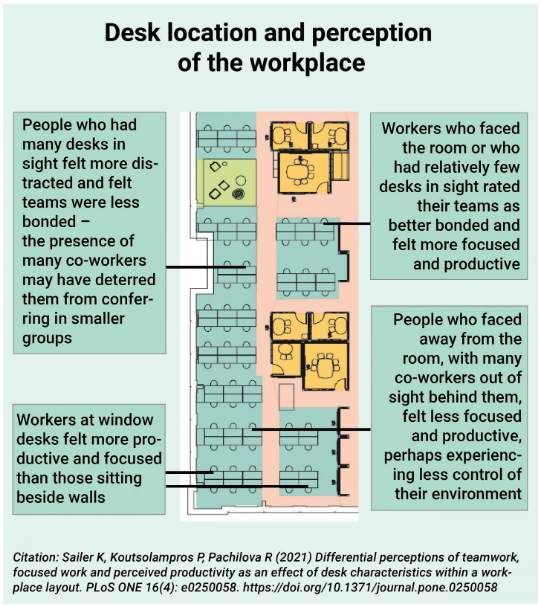Back to the office? Science reveals best desks to nab
- Published

If you are heading back to the office and get a chance to pick where you sit, choose wisely, say researchers who have been studying the science behind desk location and productivity.
The University College London team visited the HQ of a large global tech company in the city to quiz staff about their experiences of open-plan working.
Window desks and more intimate, grouped desk layouts got a big thumbs-up.
But sitting in a row with your back to lots of people was most unsettling.
The researchers say, in the journal PLoS One,, external that businesses should keep this in mind as Covid restrictions ease and more people transition from home to office-based working.
Some 172 employees took part in the survey (before the pandemic), and their responses revealed some interesting trends:
Staff with window desks felt more productive and focused than those sitting beside walls
Staff facing the room but with relatively few desks in their line of sight rated themselves more focused and productive, and their teams as better bonded
In comparison, staff facing the room but with lots of desks in front of them rated their work environment less favourably
The worst rating was by staff whose desks faced away from the main area of the room with many colleagues sitting behind them

Desk layout pros and cons
Obviously, a study of one workplace doesn't hold all the answers, and more research is needed.
But it does provide some interesting hypotheses to test.
Lead researcher Prof Kerstin Sailer, from the Bartlett School of Architecture at UCL, said: "The strongest effect we found was the visibility aspect of how many people were potentially in your view, and to what degree are those people behind you or in front of you.
"We all like a protected back. If you were facing away from the room, so there were loads of desks behind you but not so much in front of you, you would rate the environment as unfavourable."
Bigger is not always better
Being in the office provides a great opportunity to bond, collaborate and feel part of something bigger, Prof Sailer says.
But large, open-plan spaces are not always better, she says, despite many Silicon Valley companies adopting this type of design to maximise chance encounters between thousands of employees.
"Our findings raise important questions regarding the current popular practice in workplace design of providing large open-plan offices for technology companies.
"Staff in smaller open-plan spaces and those facing the room reported higher satisfaction with team cohesion, sharing information with colleagues, concentration and working productively."
A 2018 Harvard Business School study, external of two large corporate headquarters found face-to-face communication among staff decreased, following a transition to open-plan working.
But another study, external found possible health benefits from going open-plan - employees were more physically active and reported feeling less stressed.
Build in some flex
Prof Sailer said organisations could think about providing more diverse work spaces for employees, to suit different needs.
"If the office is set up well for activity-based working, ideally you have a big diversity of desks to choose from. Every seat comes with a set of certain opportunities.
"For example, if I want to concentrate today and I really need to get a report done I would go into a smaller area. But if I feel very chatty and I need to speak to a lot of people, I might go into a larger area.
"Diversity is key."
Related topics
- Published21 August 2018
